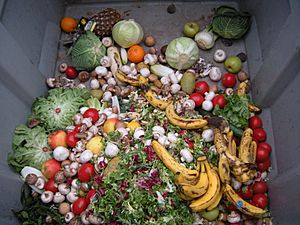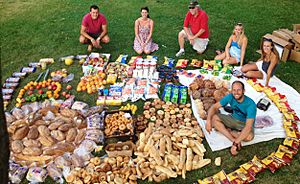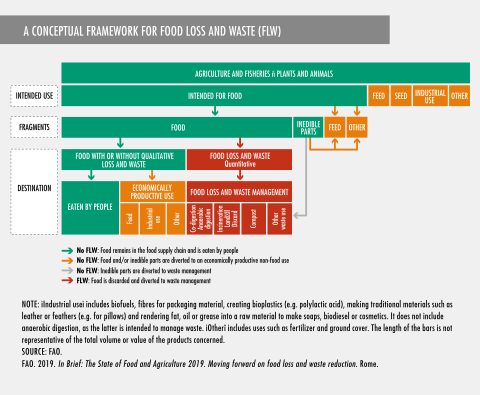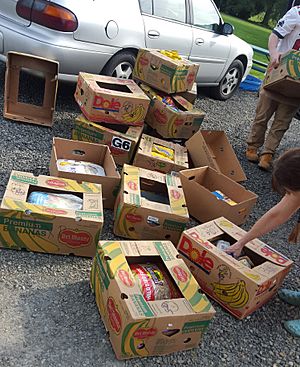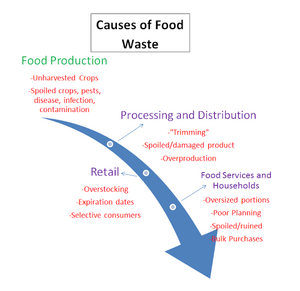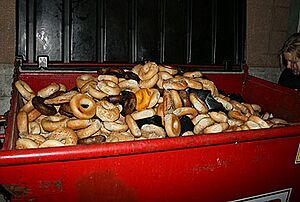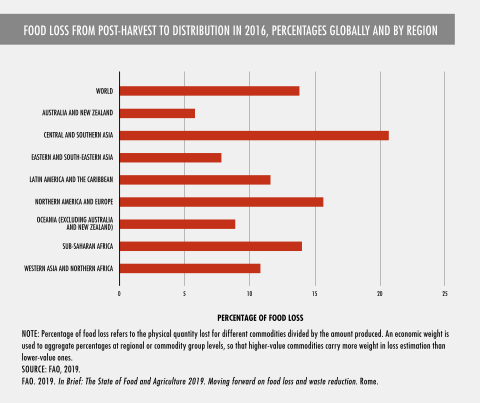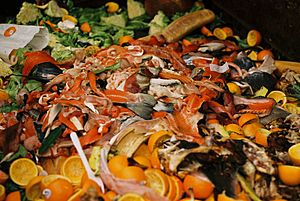Food loss and waste facts for kids
Food loss and waste is food that doesn't get eaten. This happens at every step of the food journey, from farms where food is grown, to factories where it's processed, to stores where it's sold, and finally, in our homes. About one-third of all the food made worldwide is thrown away. A lot of food that humans could eat is also given to farm animals, which means even more food is wasted.
Wasting food is a big problem for our planet. It adds to greenhouse gases that cause climate change. It also wastes land, water, and other resources used to grow and make food. The best way to deal with food waste is to prevent it from happening in the first place. If food can't be saved, the next best thing is to donate it to people who need it. Other options include feeding it to animals, recycling it, or turning it into energy. The worst option is sending it to a landfill, where it creates methane, a powerful greenhouse gas.
The United Nations has a goal to cut global food waste in half by 2030. Reducing food waste is a key part of fighting climate change and protecting our planet's biodiversity.
Contents
What is Food Loss and Waste?
Food loss and waste happens at all stages of the food journey. This includes when food is grown, processed, sold, and eaten. Different groups sometimes define these terms in slightly different ways.
United Nations' View
The Food and Agriculture Organization (FAO) of the United Nations says that food loss and waste is when the amount or quality of food goes down along the food supply chain.
- Food loss happens from the farm (harvesting, slaughtering, or catching) up to, but not including, the retail stores.
- Food waste happens at the retail stores and when people eat food at home or in restaurants.
It's important to know that food given to animals, used for compost, or turned into energy is not counted as food loss or waste. Also, parts of food that we can't eat (like banana peels or avocado pits) are not considered food loss or waste.
In 2024, a report from the United Nations Environment Programme (UNEP) highlighted that food waste causes huge money losses and adds to greenhouse gas emissions. It also uses up a lot of agricultural land. The report showed that food waste is a problem in all countries, no matter how rich or poor they are. It also said that countries like Japan and the United Kingdom are doing a good job tracking their food waste.
European Union's View
In the European Union (EU), food waste means any food that people throw away or plan to throw away. This includes drinks and chewing gum, but not things like animal feed, medicines, or tobacco. The EU has worked to create a clear definition to help countries reduce food waste. In 2016, France became the first country to ban supermarkets from throwing away or destroying unsold food. Instead, stores must donate it to charities.
United States' View
In the United States, the United States Environmental Protection Agency (EPA) uses three main ideas:
- Excess food is food that is saved and given to people.
- Food waste is food like leftovers, spoiled food, or peels that are given to animals, composted, or sent to landfills.
- Food loss is food from farms, like crops that are not harvested.
States in the U.S. can also have their own definitions for food waste.
Where Does Food Waste Happen?
Food loss and waste happens at many points in the food journey.
On the Farm (Production)
Even before food leaves the farm, it can be lost.
- Pests and bad weather can damage crops.
- Farm machines might not pick all the ripe crops.
- Farmers might not harvest crops that don't look perfect, even if they are good to eat. This is called culling. These "ugly" fruits and vegetables might be left in the field or thrown away.
In Factories (Food Processing)
After harvest, food can be lost during processing and storage.
- Pests and tiny living things (micro-organisms) can spoil food in storage, especially in hot and humid places.
- Food can lose its nutritional value or go bad if it's too hot, too cold, or too humid.
- Food safety rules can cause food to be thrown away if it doesn't meet certain standards. This is important to keep people healthy, especially with meat and dairy products.
In Stores (Retail)
Retail stores throw away a lot of food.
- Confusion about "best-before," "sell-by," or "use-by" dates makes people throw away food that is still good.
- Stores often have strict rules about how food should look. Fruits and vegetables that are oddly shaped or slightly bruised are often not put on shelves, even if they are perfectly safe to eat.
- Some stores donate unsold food to charities, while others try to prevent people from taking it.
- The fishing industry also wastes a lot of fish that are the wrong size or species.
In Restaurants (Food-service Industry)
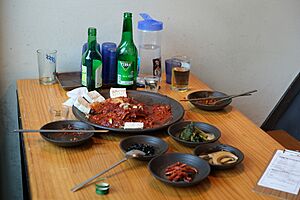
Restaurants and other food services also contribute to food waste.
- Factors like menu choices, how food is prepared, and even the size of plates can lead to waste.
- In richer countries, a lot of waste happens after customers are served. This is often because food is cheap, people have more money to spend, and they expect food to look perfect.
- One way to reduce waste in restaurants is to use smaller plates or offer smaller serving sizes.
In Our Homes (Consumption)
We, as consumers, are responsible for a lot of food waste.
- We often buy too much food and don't eat it before it spoils.
- We might misunderstand food labels and throw away food that is still good.
- Sometimes, we just take too much food and don't finish it.
- A lot of food is also wasted when we eat more than we need, which is called "metabolic food waste."
How Much Food is Wasted?
Worldwide Waste
Globally, about 14% of the world's food is lost before it even reaches stores. Fruits and vegetables are lost more often than grains. The UN Environment Programme estimates that about 931 million tonnes of food (17% of all food available to people) was thrown away in 2019. This waste came from homes, stores, and restaurants.
Here's a look at how much food is lost or wasted per person each year (from 2007):
| Region | Total | At the production and retail stages |
By consumers |
|---|---|---|---|
| Europe | 280 kg (617 lb) | 190 kg (419 lb) | 90 kg (198 lb) |
| North America and Oceania | 295 kg (650 lb) | 185 kg (408 lb) | 110 kg (243 lb) |
| Industrialized Asia | 240 kg (529 lb) | 160 kg (353 lb) | 80 kg (176 lb) |
| Sub-Saharan Africa | 160 kg (353 lb) | 155 kg (342 lb) | 5 kg (11 lb) |
| North Africa, West and Central Asia | 215 kg (474 lb) | 180 kg (397 lb) | 35 kg (77 lb) |
| South and Southeast Asia | 125 kg (276 lb) | 110 kg (243 lb) | 15 kg (33 lb) |
| Latin America | 225 kg (496 lb) | 200 kg (441 lb) | 25 kg (55 lb) |
Waste in Different Countries
Australia
Every year, Australia loses about $20 billion because of food waste. This also creates a lot of carbon dioxide (CO2) when food rots in landfills. The Australian government is working to cut food waste in half by 2030. They are funding projects to store food better and research ways to reduce waste.
Canada
In Canada, 58% of all food is wasted, which is about 35.5 million tonnes each year. This wasted food is worth about CA$21 billion. It's enough food to feed all Canadians for five months! About one-third of this waste could be saved and given to people in need. The Canadian government is working on a "Food Policy for Canada" to create a more sustainable food system.
China
In 2015, big cities in China wasted 17 to 18 million tons of food. This is enough to feed over 30 million people! In 2020, China started a campaign called "Operation Empty Plate" to encourage people to waste less food. They even considered laws to fine restaurants that encourage customers to order too much food.
Denmark
Denmark wastes over 700,000 tonnes of food each year. Thanks to a movement called "Stop Wasting Food," Denmark has cut its food waste by 25% in just five years (2010–2015).
France
France wastes about 1.3–1.9 million tonnes of food every year. This costs the country €16 billion and creates a lot of CO2 emissions. In 2016, France became the first country to make it illegal for supermarkets to throw away unsold food. Instead, stores must donate it to charities and food banks.
United Kingdom
In the UK, about 6.7 million tonnes of edible food are wasted each year. This costs households between £250 and £400 annually.
United States
The United States Department of Agriculture (USDA) says that 30–40% of food in the U.S. is wasted. This is a huge amount, worth billions of dollars each year. For example, in 2010, 26% of fish, meat, and poultry were thrown away. This means many animals are raised only to end up in landfills.
How Food Waste Harms the Environment
About one-third of all greenhouse gas emissions caused by humans are linked to food. When food is lost or wasted, it means all the resources used to produce it are also wasted.
- Land Use: A lot of land is used to grow food that is never eaten. Meat and animal products use the most land.
- Water Use: Growing food uses a lot of water. Wasting food means wasting this water. Grains and vegetables use the most water.
- Greenhouse Gas Emissions: When food rots in landfills, it creates methane, a powerful greenhouse gas. Reducing food waste helps lower these emissions.
Reducing food waste helps save water, land, and energy, and it also reduces harmful gases in the atmosphere.
Stopping Food Waste
In 2022, countries agreed to cut food waste by 50% by 2030 to help protect biodiversity. Reducing food waste helps our economy, improves food security (making sure everyone has enough to eat), and protects the environment.
There are two main ways to deal with food waste: 1. Prevention: This means stopping food from being wasted in the first place. Examples include donating food or turning it into new food products. 2. Valorisation: This means finding ways to use the materials, nutrients, or energy from food waste. Examples include making animal feed, fuel, or energy from the "waste."
Many companies are creating tools and software to help restaurants and hotels track and reduce their food waste.
Saving Food
There are many efforts to save food that would otherwise be thrown away:
- Food banks collect food and give it to people in need.
- Apps like Too Good To Go and Olio connect people with leftover food from stores or restaurants.
- Public foodsharing shelves allow people to share food.
- Dumpster diving is when people look for edible food in dumpsters.
What Consumers Can Do
We can all help reduce food waste at home:
- Plan your food shopping carefully to avoid buying too much.
- Store food properly to keep it fresh longer.
- Understand food labels (like "best-before" dates) so you don't throw away good food.
- Eat leftovers!
Campaigns like "Love Food, Hate Waste" in the UK have taught people how to store food and prepare meals to reduce waste. This led to a big drop in household food waste. "Smart packaging" could also help by showing more accurately when food is spoiled.
Collecting Food Waste
In some places, food waste is collected separately from other trash. This is good because food waste can be used in special ways. For example, in the past, food waste was often fed to pigs.
Today, some cities collect food waste separately for composting or other uses. This helps reduce the amount of waste going to landfills. Some places have "alternate weekly collections" where food waste is collected less often, which can lead to smells if not stored properly.
What Happens to Food Waste?
Instead of sending food waste to landfills, it can be:
Landfills and Greenhouse Gases
When food waste goes into a landfill, it rots and creates a bad smell. It also attracts flies and other pests. Most importantly, it produces methane, a very strong greenhouse gas that harms our climate. Many countries and cities are trying to stop sending organic waste, like food, to landfills.
Animal Feed
Large amounts of discarded fish, meat, dairy, and grains can be used to feed animals like pigs or chickens. This is a historical way of dealing with food waste. The animals turn the food into meat or dairy products. Some food waste can also be used to feed maggots, which then become food for other animals.
Composting
Food waste can be turned into compost, which is a rich, dark material that helps plants grow. This process uses tiny living things (microorganisms) to break down the food waste. Composting food waste prevents it from creating methane in landfills. Instead, it creates a useful product for farming and gardening. Some cities, like San Francisco, even require people to separate their food waste for composting.
You can also compost food waste at home! This is a great way to reduce your trash and create healthy soil for your garden.
Anaerobic Digestion
Anaerobic digestion is a process that breaks down food and other organic waste without oxygen. This creates biogas, which is mostly methane. This biogas can be burned to create electricity, which helps reduce greenhouse gas emissions. These plants can turn large amounts of food waste into energy.
See also
 In Spanish: Desperdicio alimenticio para niños
In Spanish: Desperdicio alimenticio para niños
- Gleaning
- Anaerobic digestion
- Waste & Resources Action Programme
- List of waste types
- Source Separated Organics
- Waste management


